Theater in Motion
In this lead article for the new issue of "10,000 Arts," critic Christy DeSmith offers an appreciation and short history of "movement theater," a burgeoning performance genre combining elements of dance, clowning, and traditional theater.
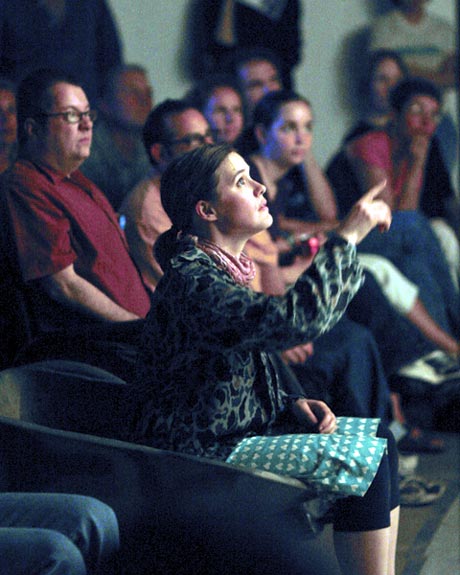
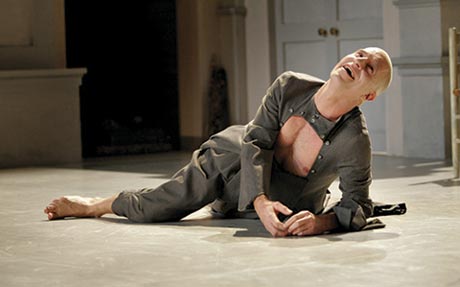

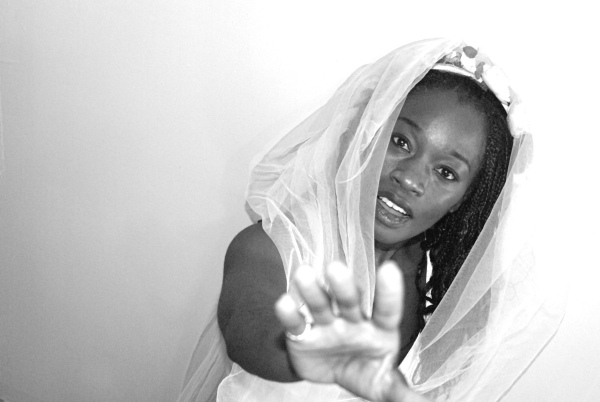
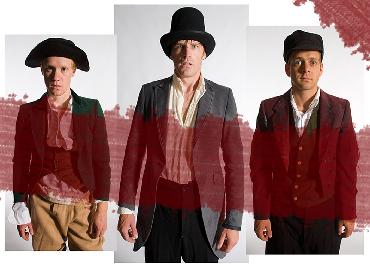
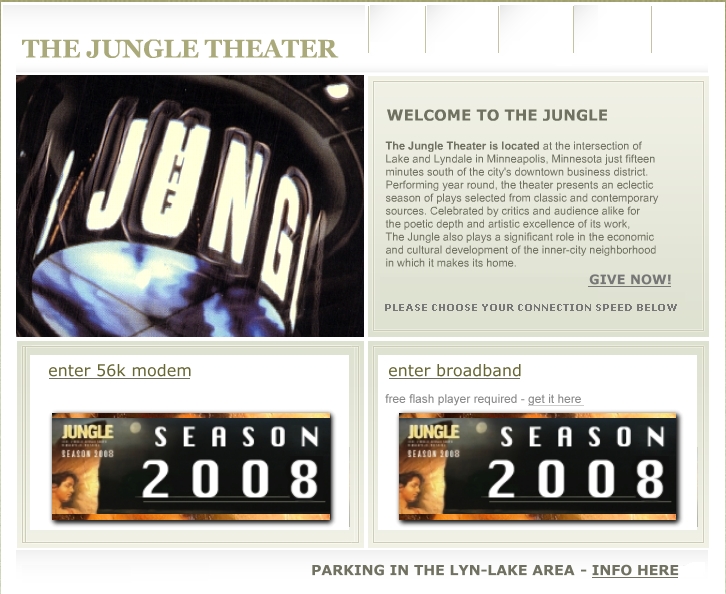

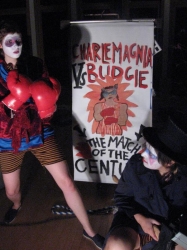
In accordance with standards for staging cosmic spectacles, (however low-budget), the cast of A Gift for Planet BX63 appeared in glittering, metallic costume. But Off-Leash Area, an inventive, burgeoning troupe based in Minneapolis, had injected its intergalactic showthink The Little Princewith another, rather unexpected feature: zero gravity. Rendered as a six-foot cube, simply constructed from plywood, mirrors, and Plexiglas, this tiny onstage world was a place in which the performer, Jennifer Ilse, could wall-dance. By balancing on her hands and kicking off the cubes various surfaceseven its ceilingIlse created the illusion of floating in space.
Her performance mixed dance, mime, and traditional text-based theater, not to mention gymnastics and contortionism. In all, it was an extraordinary demonstration of movement theater, a performance genre increasingly popular in the Twin Cities. It is, in essence, an approach that requires a heightened use of gesture and body language, as well as an awareness of the spatial relationships among the actors, the audience, and the performance space. In simple terms, its theater that has been choreographed. And as a matter of fact, theres a permeable boundary between movement theater (or physical theater, as its often called) and dance theater. Both communicate with motion more than words. The difference between them lies in the varying measure of each ingredient.
When it comes to distinguishing theater from other entertainments, especially film, immediacy and common experience are, perhaps, its supreme virtues. Theater is unique in the way it unfolds in real time at a common point shared between artists and audience, thus imbuing the live performances with a sense of connectedness that film and literature simply cannot possess. But theres another distinction less often discussed: A theater audience observes the action through a window more sweeping and panoramic in scope than that offered by film.
Exposure to cinema has caused many theatergoers, including this one, to tire of dialogue-heavy theatrical realism. Filmmakers have the luxury of using close-up shots when they wish to emulate the intimacy of real life, person-to-person conversation. In a playhouse (or for that matter, an ancient amphitheater) its difficult for the audience to see the teardrop streaking an actors cheekthat tear is simply too remote. Theater must provide something altogether different. Since the scale is so much larger, a performers broad, gestural movements will register far better than, say, the nuance of his facial expressions, especially in larger venues. The performer better communicates with thrashes and wailsand, come to think of it, the Greek chorus often functioned in this style, too.
In short, with movement theater, character is rendered physically, not emotionally. Locally, well-known examples include Steven Epps portrayal of Tartuffe in Theatre de la Jeune Lunes now-classic production of Molières play: Epp crouched in the shadows as would a predator, before leaping forth to center stage. He didnt walk so much as slither. On the other hand, in Or The White Whale, last springs adaptation of Moby Dick, director Jon Ferguson called for a lack of movementstillness in an otherwise kinetic universeto illustrate the alienation of Ishmael. In both instances, actors and directors worked to distill from complex characters their most basic, core elements. But, in translating those elements into evocative physical presences onstage, they offered more powerful understandings of these characters.
Whats more, movement theater tends not to be burdened by the formalities some folks perceive in much of the performing arts. Chalk it up to the pervasive influence of clowning and circus arts, but movement theater practitioners, to their credit, do not shy away from silliness, even if their subject matter is solemn, be it war (Please Dont Blow Up Mr. Boban, Live Action Set, 2005), the great American novel (Or The White Whale), or feigned piety (Tartuffe). That may be, in part, because the practice of such intense, often athletic physicality requires of the actors a certain youthful vigor. The resulting aesthetic is light and playful; it has a hand-made quality; its full of action, and a pleasure to behold.
Many of the Twin Cities current crop of movement theater practitioners are linked, in some way, to Theatre de la Jeune Lune. It was this company that, in 1979, imported a European style of theatrical clowning to our city. These were the very methods that the founding artistic directorsBarbra Berlovitz, Vincent Gracieux, Robert Rosen, and Dominique Serrandlearned from their Parisian teacher, the legendary Jacques Lecoq. (The most famous graduates of the École internationale de théâtre Jacques Lecoq are the founders of the enormously popular Cirque du Soleil.) The curriculum includes work in miming, masks, improvisation, studying the dynamics between performer and stage, and something called finding your inner clown.
Lecoqs teaching also emphasized a collaborative approach to creating new theatrical works, a tradition still deeply rooted in the movement theater community. This is, perhaps, the most important factor in the recent explosion of the form. From the very start, a student or apprentice of movement theater functions as an integral part of his or her ensemble. At the time of graduation, the student has already helped write, choreograph, and perform several original works. In other words, this newly minted performer is no stranger to the entire artistic process, and is therefore better prepared to strike out on his own, and, along the way, to pass these traditions along to other collaborators.
In 1985, Theatre de la Jeune Lune settled permanently in Minneapolis. As the company grew, so, too, did an inner circle of artists who studied and subscribed to this form of theater. Local clown Luverne Seifert was a company member between 1994 and 99. (These days, Seifert regularly appears with Ten Thousand Things and Frank Theaters.) Joel Sass, the Jungle Theaters associate artistic director, was a Jeune Lune company member during the early 90s. Puppeteer Michael Sommers (who founded Open Eye Figure Theatre in 2000) has been a frequent collaborator. Emerging performers like Lisa Rafaela Clair (who studied clowning with the esteemed Pierre Byland at the Burlesk Center in Switzerland) and Katie Kauffman (a graduate of the California-based DellArte International School of Physical Theatre) came to Minneapolis to study and intern with Jeune Lune. Capping off this by no means exhaustive list is freelance director Jon Fergusonin my opinion, the most exciting movement theater artist in town. And he has said he was drawn to Minneapolis, at least in part, because of the mood set by Jeune Lune. (Full disclosure: I worked for several years at Jeune Lune in an administrative capacity.)
Over the years, other movement theater companies have sprung up. Outstanding midsized companies like Ten Thousand Things and Frank Theaters frequently incorporate movement theater. Bedlam Theatre, founded in 1993, practices its own homegrown approach to creating playful, collaboratively created spectacles, relying heavily on the tenets of movement theater. Paul Herwig, who is the co-artistic director of the nine-year-old Off-Leash Area, is also a graduate of Lecoqs school; his wife and co-director, the aforementioned Jennifer Ilse, is a veteran of ballet and contemporary dance. Like Off-Leash, the delightful Live Action Set, founded in 2003, is peopled by both dancers and movement theater artists. And with any luck, a tiny troupe called 3 Sticks will soon rise to prominence as well. Founded in 2005 by students from the London International School of Performing Arts (a two-year program based on the teachings of Lecoq), 3 Sticks already has two outstanding Minnesota Fringe shows to its credit (2005s Borderlines). Artistic director Jason Bohon recently announced a slate of upcoming shows; look for their take on Alfred Hitchcocks The Birds later this year. And, of course, as these artists continue to practice their craft, thereby hooking a new generation of performers, the list of must-see movement theater will continue to grow.
About the writer: Christy DeSmith is assistant editor at The Rake, where she covers performing arts and fashion, as well as other curiosities. She occasionally freelances for the Star Tribune and the St. Paul Pioneer Press as a theater critic and was recently named an affiliated writer for 2007-08 by the Theatre Communications Group and American Theatre magazine.